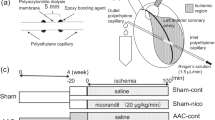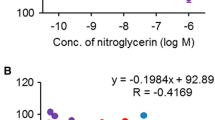Abstract
Experiments on isolated, perfused, working left ventricular (LV) hearts of 66 female Wistar rats were done to examine whether nitric oxide (NO) influences the effects of norepinephrine (NE) on coronary flow as well as on contraction and relaxation. Functional parameters were monitored before and after application of NE at a concentration of 3 × 10−8 M in the absence and presence of the nitric oxide synthase (NOS) inhibitor L-nitro-arginine (L-NA) at a concentration of 1 × 10−4 M and of the spontaneous NO donor sodium (Z)-1-(N,N-diethylamino) diazen-1-ium-1,2-diolat (DEA/NO) at a concentration of 1 × 10−7 M. In control experiments, heart rate was varied by electrical stimulation between 200 and 400 beats/min. Within this range of heart rates, coronary flow and cardiac output remained constant, while stroke volume, LV peak pressure and LV dP/dtmax decreased with increasing heart rate. NE increased coronary flow from 7.6 ± 0.4 to 9.8 ± 0.7 ml/min and induced the well-known positive chronotropic and inotropic effects. DEA/NO increased coronary flow; however, the inotropic and lusitropic parameters were not affected. Simultaneous infusion of NE with DEA/NO further increased coronary flow from 9.8 ± 0.7 to 12.1 ± 0.8 ml/min without a significant effect on any other functional parameter. When NOS was inhibited by L-NA, the positive inotropic effect of NE was attenuated. Cardiac output, however, was increased, while coronary flow did not change significantly. Under these conditions, NE increased dP/dtmax by 65.5 ± 5.8% (from 2999 ± 97 to 4929 ± 230 mmHg/s) compared with an increase by 92.8 ± 6.7% (from 3770 ± 82 to 7234 ± 211 mmHg/s) under control conditions. Application of DEA/NO reversed the attenuated inotropic response, but relaxation remained partially impaired. Thus, the presence of NO seems to be necessary for the inotropic effect of NE to become manifest.
Similar content being viewed by others
Author information
Authors and Affiliations
Additional information
Received: 9 February 2001, Returned for 1. revision: 22 February 2001, 1. Revision received: 25 May 2001, Returned for 2. revision: 12 June 2001, 2. Revision received: 20 July 2001, Returned for 3. revision: 2 August 2001, Accepted: 20 August 2001
Rights and permissions
About this article
Cite this article
Geier, S., Müller-Strahl, G. & Zimmer, HG. The inotropic response of the isolated, perfused, working rat heart to norepinephrine is attenuated by inhibition of nitric oxide. Basic Res Cardiol 97, 145–152 (2002). https://doi.org/10.1007/s003950200005
Published:
Issue Date:
DOI: https://doi.org/10.1007/s003950200005




